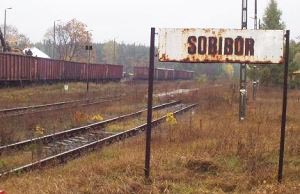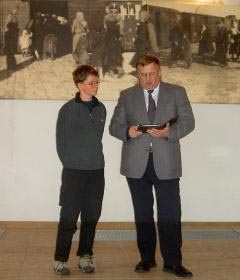Memorial avenue in Sobibor (East Poland)
Right from the start, I actively supported the memorial project initiated by the “Bildungswerk Stanislaw Hantz”, the Sobibor Memorial and the Dutch “Stichting Sobibor” in connection with the association “Rückblende gegen das Vergessen”, which I headed at the time. To create a worthy place of mourning and remembrance, trees and stones have been planted on the site of the former Sobibor extermination camp since October 2003 along the last path of the deportees. The stones bear metal plates with the names of women, men and children who were murdered here in order to make their personal fates visible again.
Excerpt from my address in Sobibor on October 14, 2003
(60th anniversary of the Sobibor uprising):
“Certainly these stones cannot express the infinite, mental and physical suffering that every single person had to endure. But each stone should tell us – not 180,000 people were murdered here, no, one person was murdered – and that has happened 180,000 times in this place of Sobibor alone! The Kassel administrative region also came to an end May / beginning of June 1942 over 500 Jewish people were deported via Lublin to Sobibor and on Murdered June 3 on the day of her arrival ”.
The memorial avenue also keeps alive the memory of the victims from our region North Hessen. So, in the meantime, with the help of many donations, memorial stones for murdered from Vokmarsen, Vöhl, Breuna, Kassel and Gudensberg have also been erected.
Memorial avenue in Sobibor
All photos of the memorial stones
in alphabetic order:
https://sobibor.de/de/steine/
https://sobibor.de/de/gedenkallee/
Since 2003, over 300 natural stones have been set up along the path of the memorial avenue over the years. They bear the names of people from Poland, the Netherlands, Germany, Austria, the Czech Republic, Slovakia and France who were murdered here. This form of commemoration of the victims and the presentation of their personal life stories in the memorial place the persecution and murder of European Jews becomes visible in an impressive way.
Archaeological investigations carried out in recent years have shown that the memorial avenue does not exactly follow the path that the Jewish victims had to take to the gas chambers.
For several years, plans have been drawn up in cooperation between different countries to redesign the present memorial and to build a museum. The “Gedenkallee” project has not yet been included in the new memorial concept, but the stones are to be placed again at a suitable location on the site of the new memorial. It is not yet clear when the plans for the redesign will be implemented. The memorial avenue therefore continues to exist in its original location.


